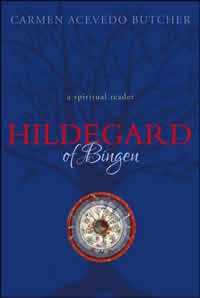Book Notes
 Carmen Acevedo Butcher, translator and editor, Hildegard of Bingen; A Spiritual Reader (Brewster, Mass.: Paraclete Press, 2007), 183pp.
Carmen Acevedo Butcher, translator and editor, Hildegard of Bingen; A Spiritual Reader (Brewster, Mass.: Paraclete Press, 2007), 183pp.
In an age when life expectancy was somewhere around forty, Hildegard of Bingen (1098–1179) lived a life that was remarkably long and incredibly productive. Butcher describes Hildegard as an "Über-multitasking Frau" and authentic "polymath." The description fits. The Benedictine abbess founded two convents, conducted four preaching tours, penned at least 400 letters, wrote music and a morality play, supervised illuminated manuscripts, cared for her fellow sisters, and wrote three major theological tomes based upon her famous visions. All this despite her pronounced feelings of self-doubt, the lack of formal schooling, chronic illnesses that probably included depression and migraine headaches, and the subservient roles assigned to women by a male-dominated church and culture.
Hildegard was born the youngest of ten children to an aristocratic family that lived near Mainz. She started having what she later concluded were divine visions as early as age three. When she was eight her parents dedicated her to the religious life, and at age fourteen she entered the St. Disibod Abbey at Disibodenberg. Until her death almost seventy years later, she devoted herself to the life of a Benedictine nun. After keeping her visions to herself for decades, when she was forty-two Hildegard says that God told her to write what she had seen and heard: "So now you must give others an intelligible account of what you see with your inner eye and what you hear with your inner ear. Your testimony will help them. As a result, others will learn how to know their Creator. They'll no longer refuse to adore God."
Butcher describes her anthology as a "Hildegard 101." After describing the life of Hildegard (pp. 1–29), her seven chapters introduce readers to Hildegard's varied works: twenty songs, Scivias or Know the Ways of the Lord (a work of twenty-six visions in three parts), her morality drama called The Play of the Virtues, selections from her 400 letters, excerpts from her writings about nature and medicine, The Book of Life's Merits (six visions about Christian temptations), and then The Book of Divine Works (10 visions in three parts). A short conclusion is followed by an extensive chronology of Hildegard's life, and a bibliography for further reading and also for listening to recordings of Hildegard's music. Butcher's short work is no substitute for the critical editions of Hildegard's works, but it might well provoke curious readers to seek them out after enjoying her fine introduction to one of the most important mothers of the church.


